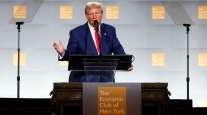US Economy Hits Milestone as Fed Tries to Keep Growth Rolling

With the calendar’s turn from April to May, the U.S. economic expansion has become the nation’s second-longest on record.
That milestone was reached as the Federal Reserve prepared to begin a two-day meeting in Washington on May 1. After a slow-but-steady slog over the past eight years and 10 months, most parts of the economy still look resilient.
The central bank has kept borrowing costs historically low since the United States crawled out of a recession in mid-2009. It is expected to leave interest rates on hold this week and plans to raise them only gradually. Meanwhile, President Donald Trump is betting on juicing growth through $1.5 trillion in tax cuts and fresh government spending.
RELATED: US growth cools to 2.3% while compensation costs accelerate
Some sectors have the potential to keep growing even as other areas may be nearing their peak. Where things go from here depends in part on how well policymakers navigate monetary policy after inflation hit their 2% target in March. Other hurdles include a U.S.-China trade dispute that could escalate. But if everything stays on track, the U.S. expansion would become the longest on record in July 2019, based on National Bureau of Economic Research figures that date to the 1850s.
With growth averaging just more than 2%, this expansion has avoided major excesses, helping it keep chugging along. Demand looks fairly solid, and economists see a tax-driven rebound restoring momentum after a first-quarter slowdown.
Still, Trump’s goal of sustained 3% economic growth remains a challenge. It’s not clear if his large stimulus, which has seldom been tried at such a late stage of an upswing, will deliver as big a boost as expected. The White House argues that corporate tax cuts will lift productivity, permitting stronger growth without a pickup in inflation that might otherwise spur the Fed to raise rates at a faster pace.
The Fed is reserving judgment on whether the tax cuts will yield such a supply-side benefit, though it’s also shown no indication so far of shifting to a steeper tightening path than the two or three more increases this year that officials projected in March.
RELATED: World trade momentum wobbles after best month in seven years
Even though inflation is edging higher, the overall cost of living remains contained. That, together with lower taxes and robust hiring, is why economists forecast a decent runway for household spending, the biggest part of the economy.
Jobs data due May 4 are expected to confirm employment picked up in April after cooling in March. The 4.1% unemployment rate, already below what generally is considered consistent with full employment, is projected to keep falling. Businesses frequently complain about a shortage of qualified workers, and the hope is that a tight job market finally may spur an acceleration in wage growth, whose tepidity has been a disappointing feature of the expansion.
Another likely driver for the expansion is business investment, though that’s vulnerable to fallout from Trump’s trade spat with China, which also has sucked in U.S. allies from Canada to Europe.
Manufacturing has been on a roll amid a recovery in oil prices, an improving global economy and steady spending by U.S. households. Investment may get a further lift from the tax cuts, but Trump’s tariffs on steel and aluminum already have caused materials prices to spike, which is weighing on factory activity.
RELATED: IMF communique reveals trade, debt seen as threats to global growth
Housing — whose collapse triggered the last recession — is on pace for moderate growth, though it faces headwinds from rising home prices and mortgage rates that have climbed to nearly a five-year high. Residential housing starts are well below the peak of the previous economic cycle, while the National Association of Realtors projects 2018 purchases of existing homes may reach the highest level since 2006.
Tax cuts and higher spending also will add to U.S. government debt. That burden, together with a fading boost from the fiscal stimulus and higher interest rates, may make 2020 a turning point for the economy.
On the other hand, the Conference Board’s leading economic index, a broad measure of the U.S. outlook, shows growth is on course for another decent run, according to Ed Yardeni, founder of Yardeni Research Inc.
“This expansion has a shot at the record books,” he wrote in a note to clients.




